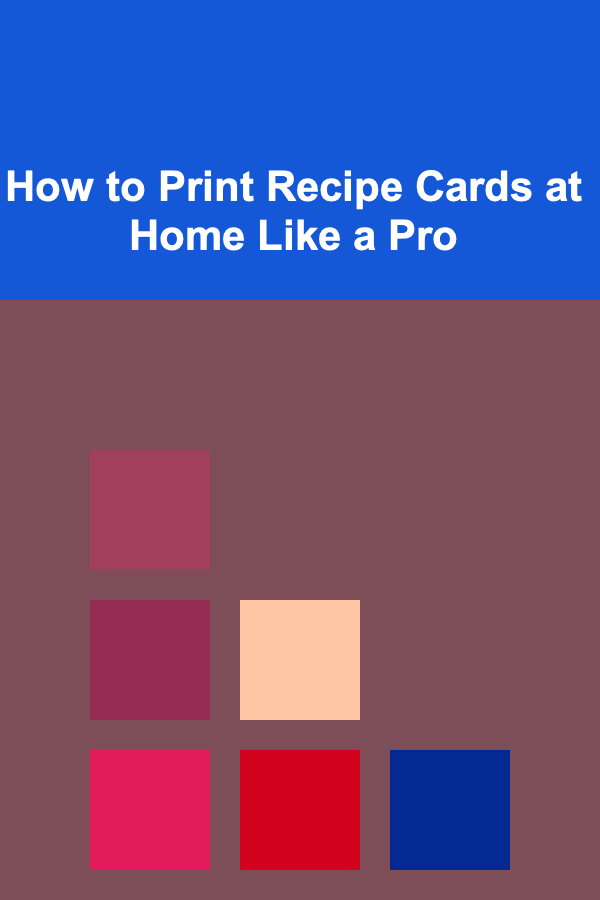
How to Print Recipe Cards at Home Like a Pro
ebook include PDF & Audio bundle (Micro Guide)
$12.99$11.99
Limited Time Offer! Order within the next:

Recipe cards have been a staple in kitchens for generations, providing a convenient and tangible way to preserve favorite meals and share them with others. In the age of digital recipes and smartphone apps, many home cooks still prefer to write down their recipes on physical cards. These cards not only serve as practical tools but also carry sentimental value, often passed down from one generation to the next. Whether you're organizing your collection or creating a personalized gift for a loved one, printing your recipe cards at home can be a fun, creative, and professional-looking process.
In this guide, we will explore how to print recipe cards at home like a pro, covering everything from selecting the right paper to using software and design tools. Whether you're a seasoned chef or a beginner in the kitchen, this article will help you produce beautiful and functional recipe cards that you'll want to use and display.
Why Print Your Own Recipe Cards?
Before diving into the process, it's important to understand why you might want to print your recipe cards at home, rather than buying pre-made ones or relying on digital files.
1.1. Customization
Printing your own recipe cards allows you to completely customize the design and layout. You can match the style to your kitchen's decor, make cards that reflect your personality, or even create themed sets for specific occasions or cuisines.
1.2. Personal Touch
Handwritten or personalized recipe cards are often more meaningful than generic, store-bought ones. By printing them yourself, you can add unique touches, like family photos, personal notes, or anecdotes that make the recipe special.
1.3. Cost-Effectiveness
Printing recipe cards at home can be more affordable than purchasing pre-designed cards, especially if you have a large collection of recipes to print. You can use inexpensive paper and ink, saving money in the long run.
1.4. Control Over Design
When you print recipe cards at home, you have full control over the design elements, such as the font, layout, and color scheme. This allows you to create a professional-looking card that suits your needs and preferences.
Materials You Will Need
Before you start printing, gather all the necessary materials. You'll need a few essential items to ensure your recipe cards come out looking polished and professional.
2.1. Paper
Choosing the right paper is one of the most important steps in the process. The paper should be thick enough to feel substantial but not too heavy that it causes printing issues. Here are some options:
- Cardstock: This is the most common choice for recipe cards. It's thick, durable, and can withstand frequent handling.
- Photo Paper: If you want high-quality, glossy cards that look more like printed photographs, photo paper is a good option.
- Linen or Textured Paper: For a more sophisticated look, you can use linen or textured paper, which adds a tactile quality to the cards.
The most common weight for recipe card paper is 80 to 100 lb. If you want cards to feel sturdy but not too bulky, this weight range is ideal.
2.2. Printer
You'll need a high-quality printer to ensure crisp, clear text and vibrant colors. Both inkjet and laser printers can be used, but inkjet printers tend to produce better results for photos and images. Ensure that your printer can handle the paper size you plan to use for your recipe cards, usually 4x6 inches or 5x7 inches.
2.3. Design Software
To create a professional-looking recipe card, you'll need a design tool to lay out the content and style. Some popular options include:
- Canva: This free online tool offers an intuitive interface with numerous templates, fonts, and design elements for creating recipe cards.
- Adobe InDesign: For more advanced users, InDesign provides extensive customization options, ideal for creating high-quality, professional cards.
- Microsoft Word: Word is a simple tool for beginners. With its built-in templates, you can quickly design recipe cards and print them.
2.4. Other Supplies
You may also need:
- Ruler and Scissors: For cutting the recipe cards to the desired size.
- Laminator (optional): If you want to preserve your cards for the long term, laminating them will protect them from spills and stains in the kitchen.
Designing Your Recipe Cards
Designing recipe cards is a creative process. Here's how you can approach it:
3.1. Choose a Template or Create Your Own
Most design software offers free templates for recipe cards, which can make the process easier. If you prefer a more custom design, you can create your own layout. Consider the following design elements:
- Size: A typical recipe card is 4x6 inches or 5x7 inches, but you can adjust this based on your preferences.
- Typography: Choose legible fonts for your recipe cards. Serif fonts work well for a traditional look, while sans-serif fonts offer a more modern aesthetic. Mix and match fonts for the title, ingredients, and instructions, but don't overcomplicate the design.
- Color Scheme: Stick to a simple color palette to maintain a cohesive look. Consider using earthy tones for a rustic style, or vibrant colors for a fun, modern design.
3.2. Layout and Content
A well-organized recipe card should be easy to read and follow. Organize the content into distinct sections:
- Title: The name of the dish should be at the top, in large, easy-to-read font.
- Ingredients: List the ingredients in order of use. You can break them into categories if the recipe is complex (e.g., "Dry Ingredients" and "Wet Ingredients").
- Instructions: Provide clear, step-by-step instructions. Be concise but informative, and consider adding small icons or illustrations for visual appeal.
- Notes: Include any extra tips, substitutions, or variations at the bottom of the card. This is also a great space for personal anecdotes or tips from family members.
3.3. Add Graphics or Photos
Personalize your recipe cards with images. This could be a photo of the finished dish, a decorative graphic, or even hand-drawn illustrations. Keep the graphics subtle so they don't overpower the text. If you are using images, ensure that they are high resolution (at least 300 DPI) to avoid pixelation when printed.
3.4. Branding (Optional)
If you're printing multiple recipe cards as part of a collection or gift set, consider adding a personal logo, your name, or a family crest to the corner. This adds a professional touch and ties the entire set together.
Printing Your Recipe Cards
Once you have finalized the design, it's time to print your recipe cards.
4.1. Test Print
Before printing the entire batch, do a test print on regular paper to ensure the design fits correctly on the card. Check the margins, font size, and overall alignment. This step will help you avoid wasting premium paper if something goes wrong.
4.2. Print Settings
Make sure you adjust your printer settings for the paper type and size. Set the printer to print at its highest quality setting to ensure a professional finish. If your printer offers color calibration options, use them to make sure your colors appear vibrant and accurate.
4.3. Printing Process
Load your cardstock into the printer, ensuring it is correctly aligned. Print one card at a time, or print multiple cards on a single sheet, depending on your design. If printing multiple cards on a single page, remember to leave enough space between each card to make cutting easier.
4.4. Cutting the Cards
Once the cards are printed, use a ruler and sharp scissors or a paper cutter to trim them to the correct size. Be precise in your cuts to ensure each card is uniform and neat.
Finishing Touches
To give your recipe cards a polished, professional look, consider the following finishing touches:
5.1. Lamination
Laminating your recipe cards helps protect them from spills and stains in the kitchen. You can laminate each card individually or use self-adhesive laminating sheets for a quicker option.
5.2. Punch a Hole and Add a Ribbon (Optional)
For a decorative touch, you can punch a hole in the corner of the card and thread a ribbon or string through it. This is especially useful if you're creating a recipe card bundle or a recipe box gift.
5.3. Store or Share
Now that your recipe cards are ready, you can store them in a recipe box or display them in a clear acrylic stand for easy access. If you're gifting them, consider presenting them in a beautifully wrapped box or binder.
Conclusion
Printing your own recipe cards at home allows you to create personalized, professional-quality cards that reflect your culinary style and personality. With the right materials, design tools, and attention to detail, you can produce recipe cards that are not only functional but also beautiful. Whether you're organizing your collection or creating a unique gift for a loved one, printing recipe cards at home can be a fun and rewarding project that will last for years to come.
Reading More From Our Other Websites
- [Organization Tip 101] How to Create a Play Zone that Encourages Organization
- [Organization Tip 101] How to Properly Maintain Your Energy-Efficient Appliances for Maximum Savings
- [Home Pet Care 101] How to Prevent Pet Hair from Taking Over Your Home
- [Home Party Planning 101] How to Make Your Home Party Comfortable for All Ages
- [Small Business 101] Business Checking Account for Small Business: What You Need to Know
- [Stamp Making Tip 101] Best Techniques to Carve Intricate Details into Polymer Clay Stamps
- [Home Budget Decorating 101] How to Incorporate DIY Home Scent Ideas into Your Decor for an Inviting Ambiance
- [Personal Care Tips 101] How to Moisturize with Body Wash: A Comprehensive Guide
- [Polymer Clay Modeling Tip 101] Advanced Baking Strategies: Controlling Temperature and Time for Ideal Curing
- [Organization Tip 101] Stenciling Walls: Transform Your Room with Minimal Effort

How to Create and Sell Deep Learning Solutions for Passive Income
Read More
How to Save Money on Insurance Premiums
Read More
How To Grasp the Concepts of V2L (Vehicle-to-Load)
Read More
How to Handle PTSD as a Firefighter
Read More
How to Create a Quilting Project Calendar
Read More
10 Tips for Safe and Responsible Shooting Range Etiquette
Read MoreOther Products

How to Create and Sell Deep Learning Solutions for Passive Income
Read More
How to Save Money on Insurance Premiums
Read More
How To Grasp the Concepts of V2L (Vehicle-to-Load)
Read More
How to Handle PTSD as a Firefighter
Read More
How to Create a Quilting Project Calendar
Read More